Legs,
Wounds, and Standing Fights in Historical Fencing
By John Clements
ARMA Director
"A full blow upon the neck,
shoulder, arm, or leg, endangers life, cuts off the veins, muscles,
and sinews, perishes the bones. These wounds made by the blow, in
respect of perfect healing, are the loss of limbs, or maims incurable
forever."
- George Silver, Paradoxes of Defence, 1598
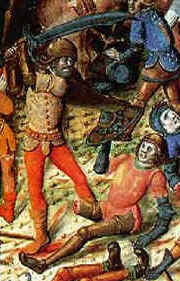 Frequently,
I’m asked by practitioners and members to comment further upon
certain unfortunate practices within versions of historical-sport
fencing games: that of electing to reflect leg and hips strikes so
as to require combatants to drop down in order to continue to play.
I refuse these requests out of hand, as they are not germane to ARMA’s
Study Approach. When I am however asked to help provide documented
evidence of the effects of leg wounds in Medieval and Renaissance
combat and their meaning in historical fencing study today, I cannot
refuse. Frequently,
I’m asked by practitioners and members to comment further upon
certain unfortunate practices within versions of historical-sport
fencing games: that of electing to reflect leg and hips strikes so
as to require combatants to drop down in order to continue to play.
I refuse these requests out of hand, as they are not germane to ARMA’s
Study Approach. When I am however asked to help provide documented
evidence of the effects of leg wounds in Medieval and Renaissance
combat and their meaning in historical fencing study today, I cannot
refuse.
Let’s take a brief look then at just what historical accounts
and descriptions of combats actually tell us about leg wounds and
standing up in fighting.
 The
ancient author Dionysius of Halicarnassus wrote of a battle in 436
BC between the Romans and the Gauls, describing how with the short
gladius the legionnaires, "would cut the tendons of their [enemies]
knees and topple them to the ground". In the 1300s, William
of Apulia writes of battle describing "Feet lopped off at the
knee and ankle" and well known are the skeletal remains from
the battle of Wisby in 1361 on the Baltic isle of Gotland off the
coast of Sweden. Excavations and forensic examinations of the remains
of more than one thousand of the fallen fighters reveal that
more than 400 of just over 1000 fighters suffered serious
leg wounds. Bones were sheared through or cracked and shattered, others
were cut to through teh muscle and tissue. Several victims even loss
both legs completely. (Thordeman, p. 167-172). The
ancient author Dionysius of Halicarnassus wrote of a battle in 436
BC between the Romans and the Gauls, describing how with the short
gladius the legionnaires, "would cut the tendons of their [enemies]
knees and topple them to the ground". In the 1300s, William
of Apulia writes of battle describing "Feet lopped off at the
knee and ankle" and well known are the skeletal remains from
the battle of Wisby in 1361 on the Baltic isle of Gotland off the
coast of Sweden. Excavations and forensic examinations of the remains
of more than one thousand of the fallen fighters reveal that
more than 400 of just over 1000 fighters suffered serious
leg wounds. Bones were sheared through or cracked and shattered, others
were cut to through teh muscle and tissue. Several victims even loss
both legs completely. (Thordeman, p. 167-172).
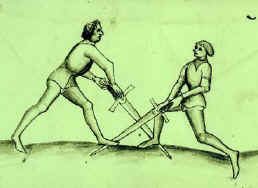 It
was even common in 15th century Spain for monetary compensation to
be paid to knights for wounds received in combat and "…the
grand sum of 120 maravedís was recommended for those who lost …a
leg below the knee." In the Fechtbuch
illustrations of Joerg Wilhalm from 1523, there are even color depictions
of fighters clearly bleeding from minor wounds to their calves during
practice with blunt great-swords. One page also shows three
separate stop-thrusts to the foot (in which the sword punctures the
armored sabaton in a splatter of bright red). The same manuscript
even shows an unarmored fighter continuing to practice with a bloodied
bandage on one of his bare calves. It
was even common in 15th century Spain for monetary compensation to
be paid to knights for wounds received in combat and "…the
grand sum of 120 maravedís was recommended for those who lost …a
leg below the knee." In the Fechtbuch
illustrations of Joerg Wilhalm from 1523, there are even color depictions
of fighters clearly bleeding from minor wounds to their calves during
practice with blunt great-swords. One page also shows three
separate stop-thrusts to the foot (in which the sword punctures the
armored sabaton in a splatter of bright red). The same manuscript
even shows an unarmored fighter continuing to practice with a bloodied
bandage on one of his bare calves.
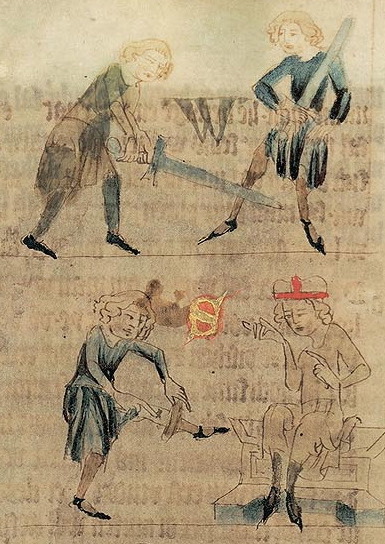 Viking
Sagas are rich with accounts of leg blows and their effects. In the
13th century Kormak’s Saga, we read how "Ogmund whirled
about his sword swiftly and shifted it from hand to hand, and hewed
Asmund’s leg from under him." In Eyrbyggja Saga we
read how "Thorarin cut the leg from thorir at the thickest of
the calf" and how Steinthor "smote at Thorleif Kimbi, and
smote the leg from him below the knee..." From the Laxdaela
Saga there is the account of how "Kjartan cut off one leg
of Gudlaug above the knee, and that hurt was enough to cause death"
as well as how "Thorleik struck him with his sword, and it caught
him on the leg above the knee and cut off his leg, and he fell to
earth dead." From the 14th century Icelandic Grettir’s
Saga, we read of Onund and how a man "struck him and took
off his leg below the knee, disabling him at a blow." From Book
I of Saxo Grammaticus’ late 12th to early 13th century Nine
Books of the Danish History, we also read how against his opponent
one warrior "clove asunder his left arm and part of his left
side and his right foot". We then read how Horwendil fought Koller
"and at last hewed off his foot and drove him lifeless to the
ground." In all these examples, with a single heavy blow
from a single-hand cutting blade the unarmored leg is hewn from the
body and the victim is immediately incapacitated or killed. Viking
Sagas are rich with accounts of leg blows and their effects. In the
13th century Kormak’s Saga, we read how "Ogmund whirled
about his sword swiftly and shifted it from hand to hand, and hewed
Asmund’s leg from under him." In Eyrbyggja Saga we
read how "Thorarin cut the leg from thorir at the thickest of
the calf" and how Steinthor "smote at Thorleif Kimbi, and
smote the leg from him below the knee..." From the Laxdaela
Saga there is the account of how "Kjartan cut off one leg
of Gudlaug above the knee, and that hurt was enough to cause death"
as well as how "Thorleik struck him with his sword, and it caught
him on the leg above the knee and cut off his leg, and he fell to
earth dead." From the 14th century Icelandic Grettir’s
Saga, we read of Onund and how a man "struck him and took
off his leg below the knee, disabling him at a blow." From Book
I of Saxo Grammaticus’ late 12th to early 13th century Nine
Books of the Danish History, we also read how against his opponent
one warrior "clove asunder his left arm and part of his left
side and his right foot". We then read how Horwendil fought Koller
"and at last hewed off his foot and drove him lifeless to the
ground." In all these examples, with a single heavy blow
from a single-hand cutting blade the unarmored leg is hewn from the
body and the victim is immediately incapacitated or killed.
From the Gesta material of c.1125, we do read the folkloric
tale of the legendary Saxon hero, Hereward the Wake, who "called
his sword 'Brainbiter'" for "He could fight twelve people
at once with it!" In one likely apocryphal episode (Gesta section
XXXII) he fought an eminent knight in single combat, which would likely
have occurred in maile byrnies with sword and shield: "Hereward
drew from its sheath a second sword… and attacked his opponent
more vigorously. And at the first blow, 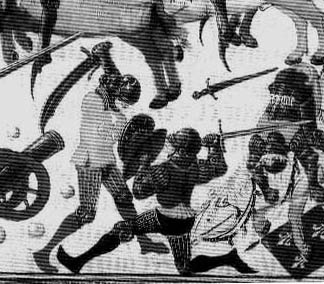 while
feigning an attack on the head, he struck the man in the middle of
his thigh. Still the soldier defended himself for some time on his
knees, declaring that for as long as there was life in him he would
never be willing to surrender or look beaten. Admiring which, Hereward
praised his bravery and courage and stopped attacking him, leaving
him and going on his way." This fictional tale says nothing of
the magnitude of the wound to the thigh and as Hereward seeks for
him to yield the soldier is only able to defend himself awhile -not
attack or strike back, just defend. From the leg blow the man is unable
to stand and falls downs to his knees, where, although he manages
to stay alive, he is unable to effectively fight, and Hereward, knowing
the man is clearly beaten, respects his refusal to surrender and so
simply walks away rather than finishing him off. Hereward knows he
can kill him easily enough… and that there is nothing to prevent
Hereward just walking away. while
feigning an attack on the head, he struck the man in the middle of
his thigh. Still the soldier defended himself for some time on his
knees, declaring that for as long as there was life in him he would
never be willing to surrender or look beaten. Admiring which, Hereward
praised his bravery and courage and stopped attacking him, leaving
him and going on his way." This fictional tale says nothing of
the magnitude of the wound to the thigh and as Hereward seeks for
him to yield the soldier is only able to defend himself awhile -not
attack or strike back, just defend. From the leg blow the man is unable
to stand and falls downs to his knees, where, although he manages
to stay alive, he is unable to effectively fight, and Hereward, knowing
the man is clearly beaten, respects his refusal to surrender and so
simply walks away rather than finishing him off. Hereward knows he
can kill him easily enough… and that there is nothing to prevent
Hereward just walking away.
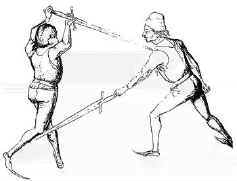 In
1263 a chivalric combat occurred in Scotland between Sir Piers de
Curry and Andrew Nicolson. As the mounted Piers brandished his spear
at Nicolson, Nicolson charged Piers on foot and with his sword struck
a blow that severed Piers thigh from his body and killed him on the
spot. In the 1300s there was a combat between two Spanish captains
at Ferrara, in which: "the combatants being engaged, one of the
parties received a desperate wound, which occasioned such a loss of
blood that he sank to the ground; when his antagonist, according the
noble institutions of chivalry, rushed on him with the point of is
sword to his throat." The combat then ceased. In
1263 a chivalric combat occurred in Scotland between Sir Piers de
Curry and Andrew Nicolson. As the mounted Piers brandished his spear
at Nicolson, Nicolson charged Piers on foot and with his sword struck
a blow that severed Piers thigh from his body and killed him on the
spot. In the 1300s there was a combat between two Spanish captains
at Ferrara, in which: "the combatants being engaged, one of the
parties received a desperate wound, which occasioned such a loss of
blood that he sank to the ground; when his antagonist, according the
noble institutions of chivalry, rushed on him with the point of is
sword to his throat." The combat then ceased.
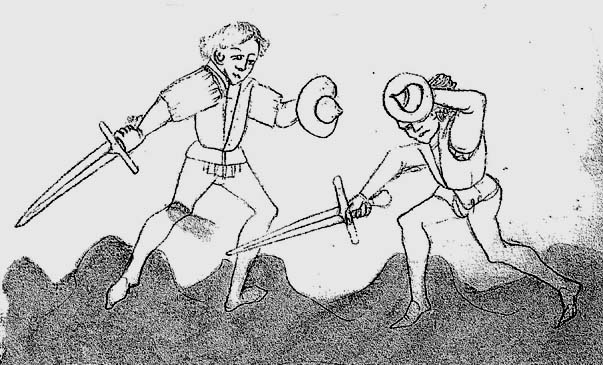 Hutton
recounts a fight in the 1400’s, as relayed by one Lindsay of
Pitscottie, between Sir Patrick Hamilton and a Dutch knight, Sir John
Cockbewis. "Then both the knightis alighted on thair foott, and
joyned pertlie togidder with rightawful countenance; each on stark
uther and foight the space of an hour with uncertaine victorie, quhill
at the last said Sir Patrick rusched rudlie upon the Duchman, and
strak him on his knies, and the Duchman being on his knies, the king
kest his hatt over the castle wall, and caused the judges to stay
and red thame; but the trumpeteris cryed out and soundit, saying the
victorie was Sir Patrickis." Once the combatant was down on his
knees, the fight was stopped. Hutton
recounts a fight in the 1400’s, as relayed by one Lindsay of
Pitscottie, between Sir Patrick Hamilton and a Dutch knight, Sir John
Cockbewis. "Then both the knightis alighted on thair foott, and
joyned pertlie togidder with rightawful countenance; each on stark
uther and foight the space of an hour with uncertaine victorie, quhill
at the last said Sir Patrick rusched rudlie upon the Duchman, and
strak him on his knies, and the Duchman being on his knies, the king
kest his hatt over the castle wall, and caused the judges to stay
and red thame; but the trumpeteris cryed out and soundit, saying the
victorie was Sir Patrickis." Once the combatant was down on his
knees, the fight was stopped.
While the idealized and often fantastical knightly combat in early
chivalric romances sometimes does provide clues to the reality of
such fighting, at other times however it represents something else
entirely. In the 12th century epic, Iwein (itself a German
version of Chrétien de Troyes' Arthurian epic Yvain)
by the Swabian knight and poet, Hartmann von Aue, we find the following
unusual comment regarding a description of two knights in single combat
with swords: 'They did not try to strike any blows below the knee
because they did not have any shields' (See Pincikowski in Classsen,
p. 105). However, from his translation work of this courtly literature,
medievalist Scott Pincikowski believes that there is no proof this
kind of statement was reflective of actual reality. Rather, he suggests
that such idealized conceptions of combat were an attempt by poets
at the time to offer chivalric knights a ritualized mode of behaving
that did not result in certain violent death or maiming to one another.
We have no way of knowing, he notes, to what degree such a statement
was followed by knights in the 11th and 12th centuries. But the very
fact that such an idea (i.e., hacking at shields and helms rather
than vulnerable legs) had to be put forward in early courtly literature
was, he feels, an indicator that it was not the norm.
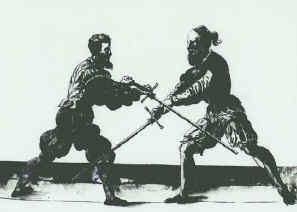 It
is sometimes suggested that tournament fights at the barriers forbade
strokes below the waist, yet the real reason for employing barriers
in the first place was to prevent grappling and wrestling between
combatants and to help to limit the lethality of contests.
Plus, for every reference to tourneys which excluded leg strikes there
can be found one that did not. In some tourneys in fact,
there were even special penalties against a knight who fell to his
knees or had to steady himself with a hand on the ground. It
is sometimes suggested that tournament fights at the barriers forbade
strokes below the waist, yet the real reason for employing barriers
in the first place was to prevent grappling and wrestling between
combatants and to help to limit the lethality of contests.
Plus, for every reference to tourneys which excluded leg strikes there
can be found one that did not. In some tourneys in fact,
there were even special penalties against a knight who fell to his
knees or had to steady himself with a hand on the ground.
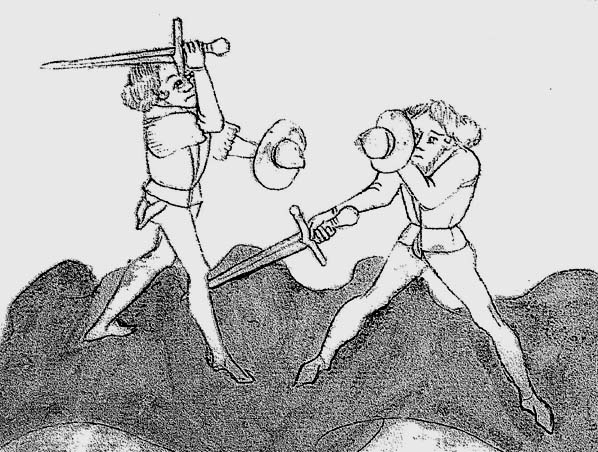 In
the 14th century tale, Le Petit Jehan De Saintré, Antoine De
Le Salle writing of a knightly duel states: "…to
combat against them on foot with pole-axes and small-swords only,
until the one party or the other should be borne to earth or disarmed
of their weapons." It was well understood that a combatant on
the ground was no challenge and realistically had no chance.
As Fiore Dei Liberi symbolized in his fighting manual of 1410, the
legs are like the strength of an elephant, a fortress, and "never
[will] I kneel down or I [will] lose my balance"—a master
of arms himself offering unequivocal advice. In
the 14th century tale, Le Petit Jehan De Saintré, Antoine De
Le Salle writing of a knightly duel states: "…to
combat against them on foot with pole-axes and small-swords only,
until the one party or the other should be borne to earth or disarmed
of their weapons." It was well understood that a combatant on
the ground was no challenge and realistically had no chance.
As Fiore Dei Liberi symbolized in his fighting manual of 1410, the
legs are like the strength of an elephant, a fortress, and "never
[will] I kneel down or I [will] lose my balance"—a master
of arms himself offering unequivocal advice.
 In
the fictional account of a 14th century knight, Le petit
Jehan de Saintré, we are told how in a challenge Saintre stood
firm and "…with the great force of his thrusting, Sir Nicolo
fell to the ground on his hands and knees. At that Saintre lifted
up his foot, for to have dealt him a buffet in the side and borne
him altogether to the ground; but for his honor’s sake he forebare."
Here we have a description of a judicial duel in which once down the
combatant is beaten, yet if desired may still continue to be attacked.
Froissart relates a judicial duel from 1386 between the Chevaliers
de Carrouges and Jacques le Gris. Witnessed by the king himself, the
ailing de Carrouges on the verge of losing was able to run his sword
through the prostrate Gris. In
the fictional account of a 14th century knight, Le petit
Jehan de Saintré, we are told how in a challenge Saintre stood
firm and "…with the great force of his thrusting, Sir Nicolo
fell to the ground on his hands and knees. At that Saintre lifted
up his foot, for to have dealt him a buffet in the side and borne
him altogether to the ground; but for his honor’s sake he forebare."
Here we have a description of a judicial duel in which once down the
combatant is beaten, yet if desired may still continue to be attacked.
Froissart relates a judicial duel from 1386 between the Chevaliers
de Carrouges and Jacques le Gris. Witnessed by the king himself, the
ailing de Carrouges on the verge of losing was able to run his sword
through the prostrate Gris.
At the battle of Crècy in 1346, the sixteen-year-old Prince
Edward, outnumbered in fierce hand-to-hand fighting became the target
of many direct attacks so that on one occasion he was briefly "compelled
to fight on his knees" (Geoffrey le Baker, Chronicon,
p. 84). But falling down while surrounded and protected
by retainers hardly qualifies as effectively fighting from a kneeling
position after being seriously wounded in a leg.
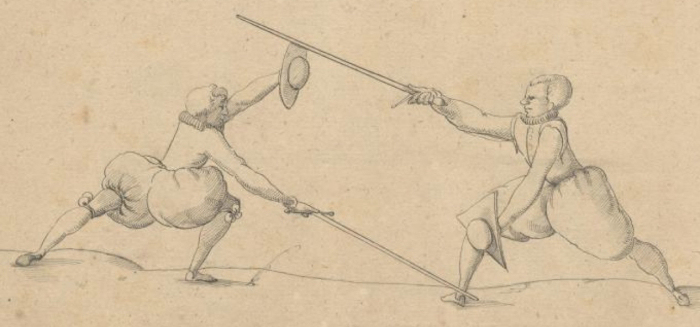
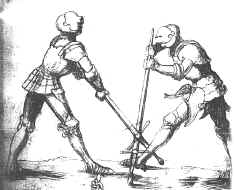 In
a duel with bastard-swords in the early 1500s, one Fendilles delivered
a thrust to the thigh of the Barron DeGuerres that laid it completely
open. Yet, despite such a terrible leg wound the Baron was still able
to charge and wrestle his opponent before dying from blood loss. The
mid 15th century English text on great-sword, MS 39564,
also instructs leg blows, stating in its 22nd entry to
"lyghtly pley a rabett at hys legge lowe by ye grownde",
while in its 23rd entry it speaks of "smytng a full
spryng at hys legge". Examining Medieval sources then, it appears only severely
hacking or copping into a leg with a sturdy cutting blade would effect
a combatant, and when it did, he would drop to the ground and no longer
be capable of fighting. With lighter, narrower Renaissance sword duels,
as well, there is no evidence whatsoever of either thrust or blow
disabling an opponent and a significant amount to the contrary. In
a duel with bastard-swords in the early 1500s, one Fendilles delivered
a thrust to the thigh of the Barron DeGuerres that laid it completely
open. Yet, despite such a terrible leg wound the Baron was still able
to charge and wrestle his opponent before dying from blood loss. The
mid 15th century English text on great-sword, MS 39564,
also instructs leg blows, stating in its 22nd entry to
"lyghtly pley a rabett at hys legge lowe by ye grownde",
while in its 23rd entry it speaks of "smytng a full
spryng at hys legge". Examining Medieval sources then, it appears only severely
hacking or copping into a leg with a sturdy cutting blade would effect
a combatant, and when it did, he would drop to the ground and no longer
be capable of fighting. With lighter, narrower Renaissance sword duels,
as well, there is no evidence whatsoever of either thrust or blow
disabling an opponent and a significant amount to the contrary.
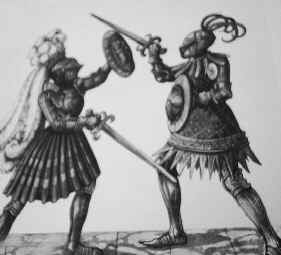 With rapiers, the results of leg wounds change but are just as interesting.
The period chronicler Brantôme for example chronicles a sword and
dagger duel from the mid 1500s wherein the combatants armored in long
"sleeves of mail" made attacks mainly at the leg .One soon
inflicted a serious and gaping wound, from which the blood flowed
freely. The wounded man still continued on and made a fierce thrust
and two rapid cuts in succession at the other, but with no success.
He did not sit or kneel. With rapiers, the results of leg wounds change but are just as interesting.
The period chronicler Brantôme for example chronicles a sword and
dagger duel from the mid 1500s wherein the combatants armored in long
"sleeves of mail" made attacks mainly at the leg .One soon
inflicted a serious and gaping wound, from which the blood flowed
freely. The wounded man still continued on and made a fierce thrust
and two rapid cuts in succession at the other, but with no success.
He did not sit or kneel.
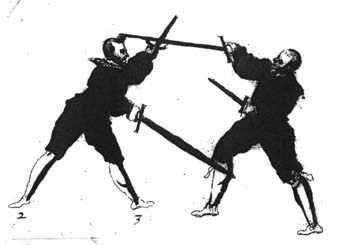 In
a duel in the early 1500s between Captain Saincte-Croix and a Spanish
Cavalier, Signor Azevedo, Saincte-Croix received such a wound on the
upper part of his thigh as laid bare the bone and caused such a flow
of blood that in trying to advance and revenge the blow he fell. On
seeing that, Azevedo tried to get Saincte-Croix to surrender, but
he just sat grasping his sword. Azevedo then said, ‘Get up; I
can’t strike you like that.’ Saincte-Croix got up and walked
two steps before falling again. Here we have no standing, no sitting
down, and no fighting. Acting as a second in a duel in the early 1500s,
Girolamo Muzio did once refuse to permit the use of armor that did
not allow kneeling, but this was because it did not allow the parties
to properly pray. In
a duel in the early 1500s between Captain Saincte-Croix and a Spanish
Cavalier, Signor Azevedo, Saincte-Croix received such a wound on the
upper part of his thigh as laid bare the bone and caused such a flow
of blood that in trying to advance and revenge the blow he fell. On
seeing that, Azevedo tried to get Saincte-Croix to surrender, but
he just sat grasping his sword. Azevedo then said, ‘Get up; I
can’t strike you like that.’ Saincte-Croix got up and walked
two steps before falling again. Here we have no standing, no sitting
down, and no fighting. Acting as a second in a duel in the early 1500s,
Girolamo Muzio did once refuse to permit the use of armor that did
not allow kneeling, but this was because it did not allow the parties
to properly pray.
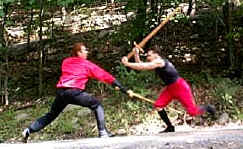 Brantôme
also informs us of a duel between Gouard and Chastaigneraye (of later
Jarnac fame) where the latter would not kill his man while he lay
fallen but waited for him to get up again. In the oft mentioned 1547
judicial duel between the nobles Chastaignerai and Jarnac, Jarnac
delivered a slicing cut behind one of his Chastaignerai’s legs
(to the ham or knee, sources are not specific). However, the accounts
are specific that from this simple cut by a light blade (the
infamous "Coup de Jarnac"), Chastaignerai instantly fell
down prone to the ground. Knowing the fight over from this result
Jarnac backed off and Chastaignerai was able to recover himself. But
from the injury he could barely stand. Resuming reluctantly, Jarnac
then made the same attack on the other leg of his stubborn but
valiant opponent and from this second atatck Chastaignerai could not
stand at all. From the first wound Jarnac well knew the fight was
over and his opponent could not continue. Chastaignerai certainly
did not sit up or continue combat from his rump or threaten to bite
Jarnac’s legs off. Brantôme
also informs us of a duel between Gouard and Chastaigneraye (of later
Jarnac fame) where the latter would not kill his man while he lay
fallen but waited for him to get up again. In the oft mentioned 1547
judicial duel between the nobles Chastaignerai and Jarnac, Jarnac
delivered a slicing cut behind one of his Chastaignerai’s legs
(to the ham or knee, sources are not specific). However, the accounts
are specific that from this simple cut by a light blade (the
infamous "Coup de Jarnac"), Chastaignerai instantly fell
down prone to the ground. Knowing the fight over from this result
Jarnac backed off and Chastaignerai was able to recover himself. But
from the injury he could barely stand. Resuming reluctantly, Jarnac
then made the same attack on the other leg of his stubborn but
valiant opponent and from this second atatck Chastaignerai could not
stand at all. From the first wound Jarnac well knew the fight was
over and his opponent could not continue. Chastaignerai certainly
did not sit up or continue combat from his rump or threaten to bite
Jarnac’s legs off.
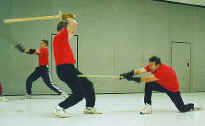 In
the mid 1500s a combat took place between Albert de Luignes and Captain
Panier, fought before the King in the woods of Vincennes, wherein
Panier inflicted a severe wound on the head of his opponent, who fell
upon his knee; his seconds ran to the rescue; but Luignes, recovering
himself, gave him a mortal wound thrust through the body. There was
no attempt to fight sitting down. In the late 1500s a duel between
Signor Amadeo and one Crequi fought on an island in the Rhone. Crequi
brought Amadeo to the ground and without more ado killed him –so
that Amadeo’s relatives later complained of the recumbent manner
in which their fellow perished. In
the mid 1500s a combat took place between Albert de Luignes and Captain
Panier, fought before the King in the woods of Vincennes, wherein
Panier inflicted a severe wound on the head of his opponent, who fell
upon his knee; his seconds ran to the rescue; but Luignes, recovering
himself, gave him a mortal wound thrust through the body. There was
no attempt to fight sitting down. In the late 1500s a duel between
Signor Amadeo and one Crequi fought on an island in the Rhone. Crequi
brought Amadeo to the ground and without more ado killed him –so
that Amadeo’s relatives later complained of the recumbent manner
in which their fellow perished.
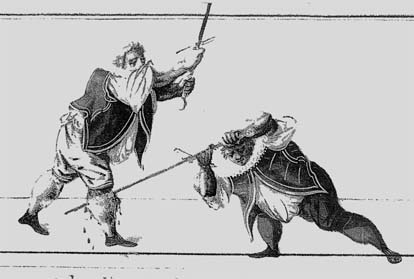 Brantôme
tells us that in the 1570’s the fugitive Baron De Vitaux with
two compatriots ambushed one Millaud in front of his own house as
he emerged (this was but one of three such surprise attacks against
other gentleman made by the Baron over the years). Before he was killed
in the assault, Millaud wounded one of his attackers in the leg with
his rapier and "caused him great loss of blood but did not prevent
his escape". Brantôme
tells us that in the 1570’s the fugitive Baron De Vitaux with
two compatriots ambushed one Millaud in front of his own house as
he emerged (this was but one of three such surprise attacks against
other gentleman made by the Baron over the years). Before he was killed
in the assault, Millaud wounded one of his attackers in the leg with
his rapier and "caused him great loss of blood but did not prevent
his escape".
In 1567, the seventeen-year-old Edward de Vere, the future 17th Earl
of Oxford, while practicing fencing with Edward Baynam, a tailor,
in the backyard of his guardian's mansion in the Strand, accidentally
wounded an unarmed undercook named Thomas Brincknell with a rapier
thrust to the thigh. Brincknell died the next day. A crooked jury
later determined Brincknell who was drunk had caused his own death
and had committed suicide by wilfully hurling himself on de Vere's
rapier. (Interestingly, this is also the earliest reference to the
rapier in England, and apparently being taught to a young noble by
a common tailor).
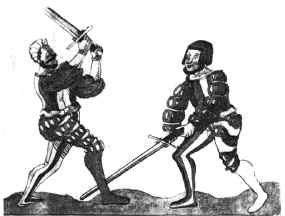 The
Master Giacomo Di Grassi in the 1570’s advised several times
in various ways that the "enimies legge must be cutt with the
edge" but never once implied doing so would cause the opponent
to drop down or keel over. Nor did Di Grassi advise any thrusting
to the legs. Vincentio Saviolo in His
Practice in Two Books, of 1594 also advises that with a wider
sharper rapier "the Scholler maye likewise give a mandritta
at the legges" and suggests "strike the said riversa or
crosse blowe at his legs". Yet,
George Silver writing on Illusions for the maintenance of imperfect
weapons & false fights in Chapter 10 of his Paradoxes,
declared that in regard to swords: "When blows were used, men
were so simple in their fight, that they thought him a coward, that
would make a thrust or a blow beneath the girdle." The
Master Giacomo Di Grassi in the 1570’s advised several times
in various ways that the "enimies legge must be cutt with the
edge" but never once implied doing so would cause the opponent
to drop down or keel over. Nor did Di Grassi advise any thrusting
to the legs. Vincentio Saviolo in His
Practice in Two Books, of 1594 also advises that with a wider
sharper rapier "the Scholler maye likewise give a mandritta
at the legges" and suggests "strike the said riversa or
crosse blowe at his legs". Yet,
George Silver writing on Illusions for the maintenance of imperfect
weapons & false fights in Chapter 10 of his Paradoxes,
declared that in regard to swords: "When blows were used, men
were so simple in their fight, that they thought him a coward, that
would make a thrust or a blow beneath the girdle."
 In Note
8 of this statement, he elaborates that when "weapons were short,
as in times past": "…to strike beneath the waist, or
at the legs, is a great disadvantage, because the course of the blow
to the legs is too far, & thereby the head, face & body is
discovered. And that was the cause in old time(s), that they did not
thrust or strike at the legs, & not for lack of skill, as is these
days we imagine." Given the evidence from tournaments and judicial
duels wherein victories were secured by thigh and leg blows, Silver
may here be referring perhaps to knightly tournaments of the early
1500s, or to earlier public Prize Playings, or even the common rough-and-tumble
street brawls with sword and buckler. In Note
8 of this statement, he elaborates that when "weapons were short,
as in times past": "…to strike beneath the waist, or
at the legs, is a great disadvantage, because the course of the blow
to the legs is too far, & thereby the head, face & body is
discovered. And that was the cause in old time(s), that they did not
thrust or strike at the legs, & not for lack of skill, as is these
days we imagine." Given the evidence from tournaments and judicial
duels wherein victories were secured by thigh and leg blows, Silver
may here be referring perhaps to knightly tournaments of the early
1500s, or to earlier public Prize Playings, or even the common rough-and-tumble
street brawls with sword and buckler.
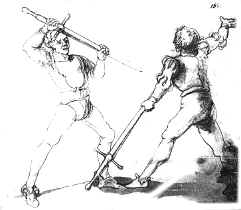 Girolamo
Cavalcabo in his text of c. 1580 is one of the very few to illustrate
any solid thrust to the leg, in this case a string straight attack
into the shin with his long, slender, tapering blade of flat-diamond
cross-section (...that's gotta hurt). Cavalcabo's action is actually
a counter attack made on the pass with a left-hand parry of the opponent's
thrust. Girolamo
Cavalcabo in his text of c. 1580 is one of the very few to illustrate
any solid thrust to the leg, in this case a string straight attack
into the shin with his long, slender, tapering blade of flat-diamond
cross-section (...that's gotta hurt). Cavalcabo's action is actually
a counter attack made on the pass with a left-hand parry of the opponent's
thrust.
The French Master Sainct Didier in 1573 advised several times
slashes to the calf of the opponent --but not the front of the leg
or the thigh. The reason being obviously that a good solid hit to
the lower leg muscle is of greater effect than a whack with a slender
blade across the hard shin bone or the thick upper leg. In his 1617
treatise on sword, rapier, and staff, Joseph Swetnam advised it was
safest to attack the adversary’s nearest target "whether
it be his dagger hand, his knee, or his leg". As he often
did, Swetnam was writing ambiguously in reference to either sword
or rapier.
|
|
|
|
|
From
a Medieval tale, Signeot versus the giant from a 15th century
manuscript.
|
Writing in 1631 of the old sword and buckler brawls,
Stowe stated, "Yet seldome any man hurt, for thrusting was not
then in use: neither would one of twentie strike beneath the waste,
by reason they helde it cowardly and beastly." What is of significance
here, is the obvious understanding that when one does strike below
the waist, serious and disabling injury results. Thus it would be
understandable such actions might have be excluded from practice playing
just as thrust to the face would have, but as we’ll see later
this was not the case.
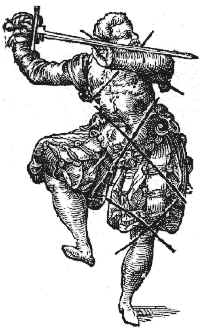 Silver, who is known for criticizing the rapiers, also complained
of the inferiority of thrusting over cutting by saying: "And
again, the thrust being made through the hand, arm, or leg, or in
many places of the body and face, are not deadly, neither are they
maims, or loss of limbs or life, neither is he much hindered for the
time in his fight, as long as the blood is hot." Silver also
argued, "I have known a Gentleman hurt in Rapier fight, in nine
or ten places through the bodie, arms, and legges, and yet hath continued
in his fight, & afterward has slaine the other". Again, no
sitting down here. Silver’s weapon was a sturdy cut-and-thrust
blade, no slender rapier and he added "…A blow upon the
hand, arme, or legge is maime incurable; but a thrust in the hand,
arme, or legge is to be recovered." In his "Circle Number
8" of his 1630 fencing treatise, Thibault mentions side stepping
to deliver a diagonal blow to the meat of the thick part of the opponent’s
thigh. But Thibault immediately adds a continuation by thrust to follow
up, and never even suggests the thigh blow was any thing than a distracting
attack to gain advantage. He, as with every other Renaissance master,
never mentions anything about a fencer sitting or kneeling. Silver, who is known for criticizing the rapiers, also complained
of the inferiority of thrusting over cutting by saying: "And
again, the thrust being made through the hand, arm, or leg, or in
many places of the body and face, are not deadly, neither are they
maims, or loss of limbs or life, neither is he much hindered for the
time in his fight, as long as the blood is hot." Silver also
argued, "I have known a Gentleman hurt in Rapier fight, in nine
or ten places through the bodie, arms, and legges, and yet hath continued
in his fight, & afterward has slaine the other". Again, no
sitting down here. Silver’s weapon was a sturdy cut-and-thrust
blade, no slender rapier and he added "…A blow upon the
hand, arme, or legge is maime incurable; but a thrust in the hand,
arme, or legge is to be recovered." In his "Circle Number
8" of his 1630 fencing treatise, Thibault mentions side stepping
to deliver a diagonal blow to the meat of the thick part of the opponent’s
thigh. But Thibault immediately adds a continuation by thrust to follow
up, and never even suggests the thigh blow was any thing than a distracting
attack to gain advantage. He, as with every other Renaissance master,
never mentions anything about a fencer sitting or kneeling.
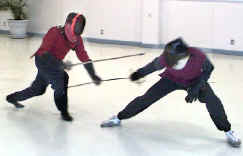 Occasionally
today in their rapier fencing enthusiasts will assume that a push
or draw cut to the inside of the thigh would be an immediate "disabling"
action because of the large arteries in those areas. The nature of
the blades, the advice of the historical masters, and modern cutting
experiments on raw meat contradict this belief. There are no accounts
of such actions where the blade is placed against the target and forcefully
drawn or pulled across ever resulting in kills during any rapier
duel or even combats with wider, sharper Medieval cutting swords.
Nor do the period manuals (such as Thibualt's) suggest such a move
would be either a killing or disabling action. Occasionally
today in their rapier fencing enthusiasts will assume that a push
or draw cut to the inside of the thigh would be an immediate "disabling"
action because of the large arteries in those areas. The nature of
the blades, the advice of the historical masters, and modern cutting
experiments on raw meat contradict this belief. There are no accounts
of such actions where the blade is placed against the target and forcefully
drawn or pulled across ever resulting in kills during any rapier
duel or even combats with wider, sharper Medieval cutting swords.
Nor do the period manuals (such as Thibualt's) suggest such a move
would be either a killing or disabling action.
 The
clothing worn at the time of the rapier is also a factor, as thick
wool or leather lined garments common in the period cannot be sliced
through by a narrow, light blade. Consider the statement by Sir James
Turner in his 1683 Pallas Armata –Military Essayes of the
Ancient Grecian, Roman, and Modern Art of War: "It were to
be wish’d that if Horsemen be obliged by their capitulation to
furnish themselves with swords, that their Officers would see them
provided of better than ordinarily most of them carry, which are such
as may be well enough resisted by either a good Felt, or a Buff-coat."
(London, Richard Chiswell, 1683, p. 171). Sir Turner makes this comment
referring to cavalry blades, so consider how much more it holds true
for either blows or "draw cuts" by the slender blade of
the rapier. As George Silver in his Paradoxes so firmly said, "A
full blow upon the head, face, arm, leg, or legs, is death, or the
party so wounded in the mercy of him that shall so wound him. For
what man shall be able long in fight to stand up, either to revenge,
or defend himself, having the veins, muscles, sinews of his hand,
arm, or leg clean cut asunder?" Examining Renaissance accounts
then, neither piercing nor slashing nor slicing upon a leg with a
rapier would have much effect upon a fighter. The
clothing worn at the time of the rapier is also a factor, as thick
wool or leather lined garments common in the period cannot be sliced
through by a narrow, light blade. Consider the statement by Sir James
Turner in his 1683 Pallas Armata –Military Essayes of the
Ancient Grecian, Roman, and Modern Art of War: "It were to
be wish’d that if Horsemen be obliged by their capitulation to
furnish themselves with swords, that their Officers would see them
provided of better than ordinarily most of them carry, which are such
as may be well enough resisted by either a good Felt, or a Buff-coat."
(London, Richard Chiswell, 1683, p. 171). Sir Turner makes this comment
referring to cavalry blades, so consider how much more it holds true
for either blows or "draw cuts" by the slender blade of
the rapier. As George Silver in his Paradoxes so firmly said, "A
full blow upon the head, face, arm, leg, or legs, is death, or the
party so wounded in the mercy of him that shall so wound him. For
what man shall be able long in fight to stand up, either to revenge,
or defend himself, having the veins, muscles, sinews of his hand,
arm, or leg clean cut asunder?" Examining Renaissance accounts
then, neither piercing nor slashing nor slicing upon a leg with a
rapier would have much effect upon a fighter.
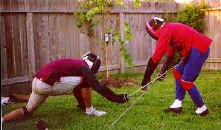 Writing
in 1662 of English "Gladiatorial" prize fighters he had
witnessed, Samuel Pepys in his famed diary described "…one
Westwicke, who was soundly cut several times both in the head and
legs, that he was all over blood; and other deadly blows they did
give and take in very good earnest, til Westwicke was in a sad pickle."
John Godfrey, commenting on the skill of the 18th century prize-fighter,
William Gill, foremost pupil of the renowned prize-fighter, James
Fig, wrote: "I never beheld any Body better for the Leg than
Gill. …he oftener hit the Leg than any one; and…his Cuts
were remarkably more severe and deep. I never was an Eye-Witness to
such a Cut in the Leg, as he gave one Butler, an Irishman, a bold
resolute Man, but an aukward Swords-Man. His Leg was laid quite open,
his Calf falling down to his Ancle". But Westwicke neither fell
nor fought from the ground. Even in a small-sword duel of 1712, the
Duke of Hamilton received a seven inch wound on the right side of
the leg, another in the right arm, a third in the upper part of the
right breast, and fourth on the outside of the left leg…yet was
survived victorious. Writing
in 1662 of English "Gladiatorial" prize fighters he had
witnessed, Samuel Pepys in his famed diary described "…one
Westwicke, who was soundly cut several times both in the head and
legs, that he was all over blood; and other deadly blows they did
give and take in very good earnest, til Westwicke was in a sad pickle."
John Godfrey, commenting on the skill of the 18th century prize-fighter,
William Gill, foremost pupil of the renowned prize-fighter, James
Fig, wrote: "I never beheld any Body better for the Leg than
Gill. …he oftener hit the Leg than any one; and…his Cuts
were remarkably more severe and deep. I never was an Eye-Witness to
such a Cut in the Leg, as he gave one Butler, an Irishman, a bold
resolute Man, but an aukward Swords-Man. His Leg was laid quite open,
his Calf falling down to his Ancle". But Westwicke neither fell
nor fought from the ground. Even in a small-sword duel of 1712, the
Duke of Hamilton received a seven inch wound on the right side of
the leg, another in the right arm, a third in the upper part of the
right breast, and fourth on the outside of the left leg…yet was
survived victorious.
 There
is no question the feet and legs were prime targets in all forms of
Medieval combat. In its finale, the 15th century "Poem of the
Pell" instructs "Hew of his honde, his legge, his theys,
his armys". In his text on swordplay from the 1480s, master Fillipo
Vadi even offered advice on what to do "if the head or left foot
are under attack, because they are closer to the enemy than the right".
From, Le Jeu de la Hache, a 15th century Burgundian treatise
on the technique of chivalric poleax combat, we read the advice: "You
can jab at his face with the queue [lower end of the haft]
of your axe, or at his". Still further it admonishes, "If
he gives you a jab to the foot with his queue, you must lift
your foot, while presenting your queue against his, which has
no protection" and "you must deliver these jabs frequently,
sometimes at the foot and sometimes at the hand or face". Achilles
Marozzo in part 4 of his 1536, Opera Nova, comments several
times on leg and foot strikes saying: "and if your enemy would
attack your head or leg, you should move your left foot sideways towards
the right side of your foe, and strike with a roverso at his head"
and if "your enemy would attack your head or legs …make
a long step…and at the same time put your sword and buckler close
together to parry the said strike, and strike his legs". There
is no question the feet and legs were prime targets in all forms of
Medieval combat. In its finale, the 15th century "Poem of the
Pell" instructs "Hew of his honde, his legge, his theys,
his armys". In his text on swordplay from the 1480s, master Fillipo
Vadi even offered advice on what to do "if the head or left foot
are under attack, because they are closer to the enemy than the right".
From, Le Jeu de la Hache, a 15th century Burgundian treatise
on the technique of chivalric poleax combat, we read the advice: "You
can jab at his face with the queue [lower end of the haft]
of your axe, or at his". Still further it admonishes, "If
he gives you a jab to the foot with his queue, you must lift
your foot, while presenting your queue against his, which has
no protection" and "you must deliver these jabs frequently,
sometimes at the foot and sometimes at the hand or face". Achilles
Marozzo in part 4 of his 1536, Opera Nova, comments several
times on leg and foot strikes saying: "and if your enemy would
attack your head or leg, you should move your left foot sideways towards
the right side of your foe, and strike with a roverso at his head"
and if "your enemy would attack your head or legs …make
a long step…and at the same time put your sword and buckler close
together to parry the said strike, and strike his legs".
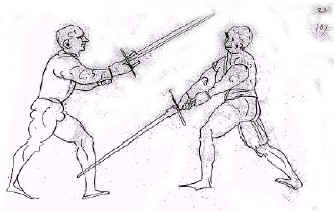 It is interesting to note that while attacks to the lower legs in
sword combat are evident in earlier combats, they begin to disappear
from swordplay by the 19th century. Some 18th & 19th century fencing
schools continued to value it to one degree or another, but various
fencing masters of the 1800’s advised against cuts to the lower
leg and upper thigh or even below the waist entirely (as is now customary
in sport saber fencing). Why the change? Such strikes were declared
by many 18th & 19th century fencing masters as too easy to avoid
by withdrawing the exposed leg and countering with cuts to the head,
arm or hand. It is interesting to note that while attacks to the lower legs in
sword combat are evident in earlier combats, they begin to disappear
from swordplay by the 19th century. Some 18th & 19th century fencing
schools continued to value it to one degree or another, but various
fencing masters of the 1800’s advised against cuts to the lower
leg and upper thigh or even below the waist entirely (as is now customary
in sport saber fencing). Why the change? Such strikes were declared
by many 18th & 19th century fencing masters as too easy to avoid
by withdrawing the exposed leg and countering with cuts to the head,
arm or hand.
They expressed exactly this standard philosophy that an able swordsman
never exposed his head and shoulders by cutting so low. But ironically,
Sir Richard Burton (who subscribed to this very view) admitted in
his 1876, A New System of Sword Exercise for Infantry, that
"In our Single-stick practice the first thought seems to be to
attack the advanced leg –which may be well enough for Single-stick"
(in his mid 19th century Sentiments of the Sword, Burton had
also noted how the "Oriental [e.g. Indian or Arab] affects only
two cuts, the shoulder blow and the "kulam," or leg slash).
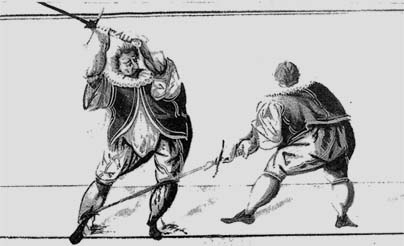 Defending
against leg strikes by moving the target and hitting back was certainly
nothing new in later times, it was an element in all earlier fighting
and is even detectable in Fiore’s manual as well as Sigmund Ringeck’s
and Marozzo’s. Among the different saber-schools of the
19th century, polite manners and gentlemanly consensus, not necessarily
martial effectiveness, could frequently determined acceptable target
areas for practice or duel (actually, leg targets were included in
some schools of sport sabre fencing up until the early 20th century).
Yet obviously, as swords lost more and more of their military value
and cutting actions went from full cleaving blows to light slashes
from the wrist and elbow, the nature of swordplay changed (not to
mention that shorter, lighter blades are employed differently than
dedicated cutting swords used with shield, buckler, or dagger, and
are different still from longer double-hand weapons used against armors). Defending
against leg strikes by moving the target and hitting back was certainly
nothing new in later times, it was an element in all earlier fighting
and is even detectable in Fiore’s manual as well as Sigmund Ringeck’s
and Marozzo’s. Among the different saber-schools of the
19th century, polite manners and gentlemanly consensus, not necessarily
martial effectiveness, could frequently determined acceptable target
areas for practice or duel (actually, leg targets were included in
some schools of sport sabre fencing up until the early 20th century).
Yet obviously, as swords lost more and more of their military value
and cutting actions went from full cleaving blows to light slashes
from the wrist and elbow, the nature of swordplay changed (not to
mention that shorter, lighter blades are employed differently than
dedicated cutting swords used with shield, buckler, or dagger, and
are different still from longer double-hand weapons used against armors).
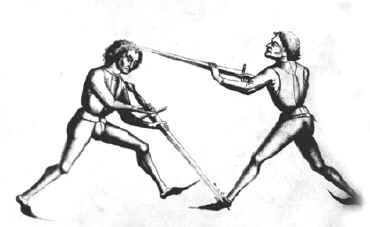 Curiously,
the master Fiore Dei Liberi in his treatise of 1410 reasonably advised:
"When someone strikes to your leg, step slip with your forefoot.
You retreat backwards and strike a downward cut in his head..."
This same advice was to be found in many later works. However, he
then asserted (despite the iconographic and practical evidence to
the contrary from the era) that low leg hits were specifically impractical
with a longsword: "With a two-handed sword you can not strike
well from the knee downwards, because it is very dangerous for the
one who strikes, because the one who attacks the leg remains all uncovered.
Unless one has fallen on the ground, then he can injure the leg well,
otherwise you can not, being sword against sword." His
logic was sound, and yet the longer the weapon the easier lower leg
hits are. Curiously,
the master Fiore Dei Liberi in his treatise of 1410 reasonably advised:
"When someone strikes to your leg, step slip with your forefoot.
You retreat backwards and strike a downward cut in his head..."
This same advice was to be found in many later works. However, he
then asserted (despite the iconographic and practical evidence to
the contrary from the era) that low leg hits were specifically impractical
with a longsword: "With a two-handed sword you can not strike
well from the knee downwards, because it is very dangerous for the
one who strikes, because the one who attacks the leg remains all uncovered.
Unless one has fallen on the ground, then he can injure the leg well,
otherwise you can not, being sword against sword." His
logic was sound, and yet the longer the weapon the easier lower leg
hits are.
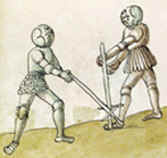 Leg wounds thus, are either very serious matters or not at all. There
appears little in between. Even in later combats this was still true.
In an 1846 official duel at Munster, two young officers fought with
sabres in a roped off area. One received two slight cuts on the arm
but soon gave his opponent "a cut in the thigh which toppled
him over upon the ground, and made it impossible for him to continue
the combat." In an 1858 epee’ duel in France, the Marquis
de Galiffet and De Lauriston fought for 30 minutes. The latter was
wounded in the hand and the former pierced in the thigh so that the
physician concluded he could not continue. Leg wounds thus, are either very serious matters or not at all. There
appears little in between. Even in later combats this was still true.
In an 1846 official duel at Munster, two young officers fought with
sabres in a roped off area. One received two slight cuts on the arm
but soon gave his opponent "a cut in the thigh which toppled
him over upon the ground, and made it impossible for him to continue
the combat." In an 1858 epee’ duel in France, the Marquis
de Galiffet and De Lauriston fought for 30 minutes. The latter was
wounded in the hand and the former pierced in the thigh so that the
physician concluded he could not continue.
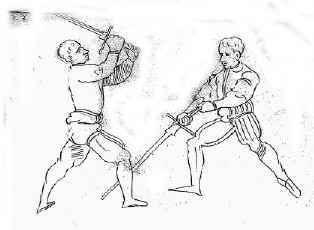 So what conclusions can we draw then? Without a doubt, the factors
of physiology and psychology are important in the effects of any wounds.
Yet even today law enforcement and military specialists will comment
that firearm wounds to the legs either break and shatter bone –thus
preventing standing –or else do not disable the victim from standing
and even running. From Viking Sagas in the 9th century to British
Army reports in the 19th, there are accounts of blows by cutting blades
removing legs above the knee or both legs below the knee… but
never once of any combatants sitting or kneeling to fight while wounded
in the hips or legs. Thus, when wounded by a leg blow, depending
on the severity of the attack, a fighter either immediately fell down
if it was grievous or else they managed to continue on without toppling
over. Leg wounds even seem to make up a larger portion of injuries
in sword combat than any other except head wounds. This is no
surprise since arms and torsos are often protected by shields and
are more easily armored (besides, feinting high and striking low is
a fundamental attack). So what conclusions can we draw then? Without a doubt, the factors
of physiology and psychology are important in the effects of any wounds.
Yet even today law enforcement and military specialists will comment
that firearm wounds to the legs either break and shatter bone –thus
preventing standing –or else do not disable the victim from standing
and even running. From Viking Sagas in the 9th century to British
Army reports in the 19th, there are accounts of blows by cutting blades
removing legs above the knee or both legs below the knee… but
never once of any combatants sitting or kneeling to fight while wounded
in the hips or legs. Thus, when wounded by a leg blow, depending
on the severity of the attack, a fighter either immediately fell down
if it was grievous or else they managed to continue on without toppling
over. Leg wounds even seem to make up a larger portion of injuries
in sword combat than any other except head wounds. This is no
surprise since arms and torsos are often protected by shields and
are more easily armored (besides, feinting high and striking low is
a fundamental attack).
From an anonymous 15th century German manuscript illustrating a chivalric
romance a villainous knight his defeated only after he is chopped
to pieces limb by limb in a Pythonesque scene. From the work, one
knight in a judicial duel is shown knocked from his horse and severely
wounded struggling to rise from his knees as his opponent prepares
to finish him.
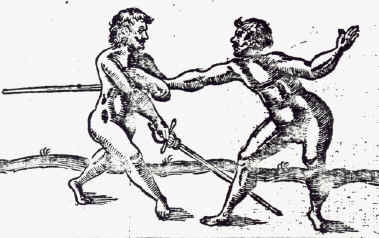 As can be seen in the above cases of recorded historical combats,
there is no sitting or kneeling whilst fighting…and no attacking
of opponents while sitting. There is nothing within any account
of Medieval or Renaissance combat to support doing so as a reasonable
simulation of weapon injury. Nor is there any chivalric
or code duello evidence in favor of the practice, whether in battle,
tourney, judicial combat, affray, or private duel of honor. There
simply is zero historical, physiological, forensic, or martial legitimacy
to the assumptions supporting the practice of continuing free-play
or mock-fighting from a kneeling or sitting position. Indeed,
there is in fact no evidence whatsoever for such practices within
study of a subject as exciting and rich as Medieval & Renaissance
combat. Is it any surprise that not one of the more than 100 surviving
historical fencing texts (both printed books and un-published manuscript)
from the 13th to the 17th centuries offer us a single "technique
for fighting from the ground"? Perhaps these facts will
eventually give pause to historical groups wherein the lamentable
habit of conducting fencing while sitting or kneeling is conducted…a
habit whose fundamental premise is without historical foundation or
martial validity. As can be seen in the above cases of recorded historical combats,
there is no sitting or kneeling whilst fighting…and no attacking
of opponents while sitting. There is nothing within any account
of Medieval or Renaissance combat to support doing so as a reasonable
simulation of weapon injury. Nor is there any chivalric
or code duello evidence in favor of the practice, whether in battle,
tourney, judicial combat, affray, or private duel of honor. There
simply is zero historical, physiological, forensic, or martial legitimacy
to the assumptions supporting the practice of continuing free-play
or mock-fighting from a kneeling or sitting position. Indeed,
there is in fact no evidence whatsoever for such practices within
study of a subject as exciting and rich as Medieval & Renaissance
combat. Is it any surprise that not one of the more than 100 surviving
historical fencing texts (both printed books and un-published manuscript)
from the 13th to the 17th centuries offer us a single "technique
for fighting from the ground"? Perhaps these facts will
eventually give pause to historical groups wherein the lamentable
habit of conducting fencing while sitting or kneeling is conducted…a
habit whose fundamental premise is without historical foundation or
martial validity.
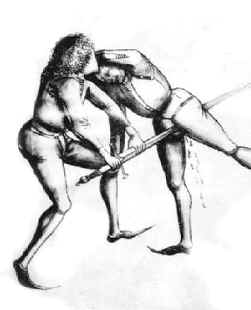
"Beholde a fencer, who making at his
enimies head,
striketh him on the legge"
- Guazzo
Note: This material was compiled from
the forthcoming book on Histrocial Fencing by the author, source
references were removed from the online version. Copyright (c) 2000
See also: Kneeling
Down in Weapon Sparring Rules and Importance of the Full Leg Target in Weapon Sparring
Back to the Essays Page |

